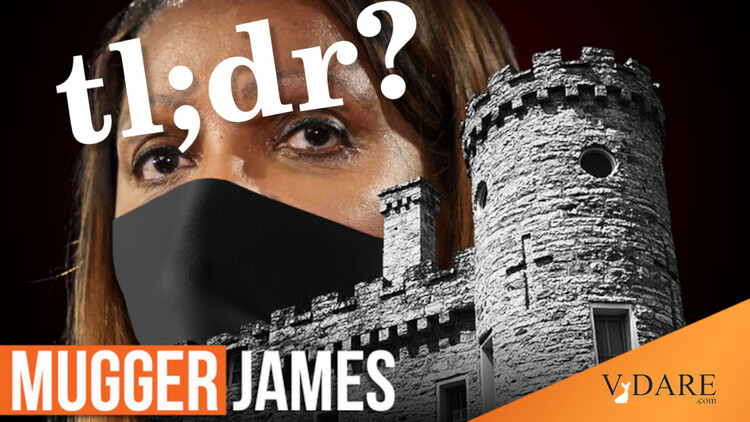From The Atlantic, an article by psychologist Jonathan Haidt (whose book, The Righteous Mind, I reviewed for Taki’s in 2012) and Greg Lukianoff of FIRE. Their basic argument is that the current college mindset of mania about microaggressions and trigger warnings is therapy perfectly designed to worsen the mental health of college students by engraining in them self-destructive “habits of mind” that are the exact inverses of the effective habits of mind taught by Cognitive Behavioral Therapy, which is often the most cost-effective form of psychological therapy. Of course, making young people unhappier and more dependent upon institutions is considered a feature, not a bug by people who hope to make a living out of preying upon the young.
The Coddling of the American MindIn the name of emotional well-being, college students are increasingly demanding protection from words and ideas they don’t like. Here’s why that’s disastrous for education—and mental health.
GREG LUKIANOFF AND JONATHAN HAIDT SEPTEMBER 2015 ISSUE
Something strange is happening at America’s colleges and universities. A movement is arising, undirected and driven largely by students, to scrub campuses clean of words, ideas, and subjects that might cause discomfort or give offense. …
Two terms have risen quickly from obscurity into common campus parlance. Microaggressions are small actions or word choices that seem on their face to have no malicious intent but that are thought of as a kind of violence nonetheless.
When I first wrote a column on the cult of microaggressions in March 2013, I worried that I was making a mountain out of a molehill, that the term was such an easy joke that it would die out. But instead it has gotten increasingly institutionalized.
… Trigger warnings are alerts that professors are expected to issue if something in a course might cause a strong emotional response. …The press has typically described these developments as a resurgence of political correctness. That’s partly right, although there are important differences between what’s happening now and what happened in the 1980s and ’90s. That movement sought to restrict speech (specifically hate speech aimed at marginalized groups), but it also challenged the literary, philosophical, and historical canon, seeking to widen it by including more-diverse perspectives. The current movement is largely about emotional well-being.
The Diversify the Canon craze of 25 years ago in college English departments was largely about catering to the resentments and insecurities of everybody who wasn’t a Dead White European Male, combined with increasing job security for English professors by creating a barrier to entry to teaching college English of mastering the jargon of some intentionally badly written Continental Theory that most people who love good writing wouldn’t want to do.
But it turned out that Shakespeare really is that good, and the people that students truly look up to, celebrities, often continue to find Shakespeare inspiring, so Shakespeare’s coolness couldn’t be scratched by 1990s’ Canon resentment.
More than the last, it presumes an extraordinary fragility of the collegiate psyche, and therefore elevates the goal of protecting students from psychological harm.
When I was looking into a hate hoax at Claremont Colleges in April 2004, I was struck by how obsessed the institutional apparatus was with “campus climate” (which was, at the time I visited, 72 degrees F with a 5 mph breeze gently wafting across the flowering campus but not blowing so hard as to interfere with the students playing frisbee golf).
The ultimate aim, it seems, is to turn campuses into “safe spaces” where young adults are shielded from words and ideas that make some uncomfortable. And more than the last, this movement seeks to punish anyone who interferes with that aim, even accidentally. You might call this impulse vindictive protectiveness. It is creating a culture in which everyone must think twice before speaking up, lest they face charges of insensitivity, aggression, or worse.
Another way to look at it is: We get to insult you, but you don’t get to insult us or even to laugh at us. “Who? Whom?” for me, but not for thee.
… But in this essay we focus on a different question: What are the effects of this new protectiveness on the students themselves? Does it benefit the people it is supposed to help? What exactly are students learning when they spend four years or more in a community that polices unintentional slights, places warning labels on works of classic literature, and in many other ways conveys the sense that words can be forms of violence that require strict control by campus authorities, who are expected to act as both protectors and prosecutors?There’s a saying common in education circles: Don’t teach students what to think; teach them how to think. The idea goes back at least as far as Socrates. Today, what we call the Socratic method is a way of teaching that fosters critical thinking, in part by encouraging students to question their own unexamined beliefs, as well as the received wisdom of those around them. Such questioning sometimes leads to discomfort, and even to anger, on the way to understanding.
But vindictive protectiveness teaches students to think in a very different way. It prepares them poorly for professional life, which often demands intellectual engagement with people and ideas one might find uncongenial or wrong. The harm may be more immediate, too. A campus culture devoted to policing speech and punishing speakers is likely to engender patterns of thought that are surprisingly similar to those long identified by cognitive behavioral therapists as causes of depression and anxiety. The new protectiveness may be teaching students to think pathologically.
How Did We Get Here?
It’s difficult to know exactly why vindictive protectiveness has burst forth so powerfully in the past few years.
Don’t forget to include in the list the Obama re-election campaign.
The phenomenon may be related to recent changes in the interpretation of federal antidiscrimination statutes (about which more later). But the answer probably involves generational shifts as well. Childhood itself has changed greatly during the past generation. …Social media makes it extraordinarily easy to join crusades, express solidarity and outrage, and shun traitors.
On The Simpsons, large crowds are constantly assembling to be harangued by demagogic orators who enraged them into a torch-carrying mob. Personally, this looks like a blast, but it doesn’t happen much in modern American life because we’re home watching TV.
Social media, however, lets the petty vindictiveness of village gossip go national.
The Thinking CureFor millennia, philosophers have understood that we don’t see life as it is; we see a version distorted by our hopes, fears, and other attachments. The Buddha said, “Our life is the creation of our mind.” Marcus Aurelius said, “Life itself is but what you deem it.” The quest for wisdom in many traditions begins with this insight. Early Buddhists and the Stoics, for example, developed practices for reducing attachments, thinking more clearly, and finding release from the emotional torments of normal mental life.
Cognitive behavioral therapy is a modern embodiment of this ancient wisdom. It is the most extensively studied nonpharmaceutical treatment of mental illness, and is used widely to treat depression, anxiety disorders, eating disorders, and addiction. It can even be of help to schizophrenics. No other form of psychotherapy has been shown to work for a broader range of problems. Studies have generally found that it is as effective as antidepressant drugs (such as Prozac) in the treatment of anxiety and depression. The therapy is relatively quick and easy to learn; after a few months of training, many patients can do it on their own. Unlike drugs, cognitive behavioral therapy keeps working long after treatment is stopped, because it teaches thinking skills that people can continue to use.
The goal is to minimize distorted thinking and see the world more accurately. You start by learning the names of the dozen or so most common cognitive distortions (such as overgeneralizing, discounting positives, and emotional reasoning; see the list at the bottom of this article). Each time you notice yourself falling prey to one of them, you name it, describe the facts of the situation, consider alternative interpretations, and then choose an interpretation of events more in line with those facts. Your emotions follow your new interpretation. In time, this process becomes automatic. When people improve their mental hygiene in this way—when they free themselves from the repetitive irrational thoughts that had previously filled so much of their consciousness—they become less depressed, anxious, and angry.
CBT is not a miracle cure, and reported effectiveness has been dropping over time for whatever reason. But it’s a good thing to know about.
The parallel to formal education is clear: cognitive behavioral therapy teaches good critical-thinking skills, the sort that educators have striven for so long to impart. By almost any definition, critical thinking requires grounding one’s beliefs in evidence rather than in emotion or desire, and learning how to search for and evaluate evidence that might contradict one’s initial hypothesis. But does campus life today foster critical thinking? Or does it coax students to think in more-distorted ways?… Burns defines emotional reasoning as assuming “that your negative emotions necessarily reflect the way things really are: ‘I feel it, therefore it must be true.’?” Leahy, Holland, and McGinn define it as letting “your feelings guide your interpretation of reality.” …
Emotional reasoning dominates many campus debates and discussions. A claim that someone’s words are “offensive” is not just an expression of one’s own subjective feeling of offendedness. It is, rather, a public charge that the speaker has done something objectively wrong. It is a demand that the speaker apologize or be punished by some authority for committing an offense.
There have always been some people who believe they have a right not to be offended. Yet throughout American history—from the Victorian era to the free-speech activism of the 1960s and ’70s—radicals have pushed boundaries and mocked prevailing sensibilities. Sometime in the 1980s, however, college campuses began to focus on preventing offensive speech, especially speech that might be hurtful to women or minority groups. The sentiment underpinning this goal was laudable, but it quickly produced some absurd results. …
Because there is a broad ban in academic circles on “blaming the victim,” it is generally considered unacceptable to question the reasonableness (let alone the sincerity) of someone’s emotional state, particularly if those emotions are linked to one’s group identity. …
Since 2013, new pressure from the federal government has reinforced this trend. Federal antidiscrimination statutes regulate on-campus harassment and unequal treatment based on sex, race, religion, and national origin. Until recently, the Department of Education’s Office for Civil Rights acknowledged that speech must be “objectively offensive” before it could be deemed actionable as sexual harassment—it would have to pass the “reasonable person” test. To be prohibited, the office wrote in 2003, allegedly harassing speech would have to go “beyond the mere expression of views, words, symbols or thoughts that some person finds offensive.”
But in 2013, the Departments of Justice and Education greatly broadened the definition of sexual harassment to include verbal conduct that is simply “unwelcome.” Out of fear of federal investigations, universities are now applying that standard—defining unwelcome speech as harassment—not just to sex, but to race, religion, and veteran status as well. Everyone is supposed to rely upon his or her own subjective feelings to decide whether a comment by a professor or a fellow student is unwelcome, and therefore grounds for a harassment claim. Emotional reasoning is now accepted as evidence.
If our universities are teaching students that their emotions can be used effectively as weapons—or at least as evidence in administrative proceedings—then they are teaching students to nurture a kind of hypersensitivity that will lead them into countless drawn-out conflicts in college and beyond. Schools may be training students in thinking styles that will damage their careers and friendships, along with their mental health. …
It’s hard to imagine how novels illustrating classism and privilege could provoke or reactivate the kind of terror that is typically implicated in PTSD. Rather, trigger warnings are sometimes demanded for a long list of ideas and attitudes that some students find politically offensive, in the name of preventing other students from being harmed. This is an example of what psychologists call “motivated reasoning”—we spontaneously generate arguments for conclusions we want to support. Once you find something hateful, it is easy to argue that exposure to the hateful thing could traumatize some other people.
… Classroom discussions are safe places to be exposed to incidental reminders of trauma (such as the word violate). A discussion of violence is unlikely to be followed by actual violence, so it is a good way to help students change the associations that are causing them discomfort. And they’d better get their habituation done in college, because the world beyond college will be far less willing to accommodate requests for trigger warnings and opt-outs. …
Just you wait … The corporate and government worlds has at least as much money to waste on squeaky wheels as the higher ed world.
The expansive use of trigger warnings may also foster unhealthy mental habits in the vastly larger group of students who do not suffer from PTSD or other anxiety disorders. People acquire their fears not just from their own past experiences, but from social learning as well.… Burns defines magnification as “exaggerat[ing] the importance of things,” and Leahy, Holland, and McGinn define labeling as “assign[ing] global negative traits to yourself and others.” The recent collegiate trend of uncovering allegedly racist, sexist, classist, or otherwise discriminatory microaggressions doesn’t incidentally teach students to focus on small or accidental slights. Its purpose is to get students to focus on them and then relabel the people who have made such remarks as aggressors.
… Even joking about microaggressions can be seen as an aggression, warranting punishment.
Since the term “microaggression” is inherently comic, laughter is a good way to smoke out badthinkers.
What are we doing to our students if we encourage them to develop extra-thin skin in the years just before they leave the cocoon of adult protection and enter the workforce?
We’re creating even more conduct-policing makework jobs for cadres of SJWs in the adult world, which is, to a sizable extent, the point.
… Burns defines catastrophizing as a kind of magnification that turns “commonplace negative events into nightmarish monsters.” Leahy, Holland, and McGinn define it as believing “that what has happened or will happen” is “so awful and unbearable that you won’t be able to stand it.” Requests for trigger warnings involve catastrophizing, but this way of thinking colors other areas of campus thought as well….All of these actions teach a common lesson: smart people do, in fact, overreact to innocuous speech, make mountains out of molehills, and seek punishment for anyone whose words make anyone else feel uncomfortable.
… As Burns defines it, mental filtering is “pick[ing] out a negative detail in any situation and dwell[ing] on it exclusively, thus perceiving that the whole situation is negative.” Leahy, Holland, and McGinn refer to this as “negative filtering,” which they define as “focus[ing] almost exclusively on the negatives and seldom notic[ing] the positives.” When applied to campus life, mental filtering allows for simpleminded demonization.
If campus culture conveys the idea that visitors must be pure, with résumés that never offend generally left-leaning campus sensibilities, then higher education will have taken a further step toward intellectual homogeneity and the creation of an environment in which students rarely encounter diverse viewpoints. And universities will have reinforced the belief that it’s okay to filter out the positive. If students graduate believing that they can learn nothing from people they dislike or from those with whom they disagree, we will have done them a great intellectual disservice. …
The biggest single step in the right direction does not involve faculty or university administrators, but rather the federal government, which should release universities from their fear of unreasonable investigation and sanctions by the Department of Education. Congress should define peer-on-peer harassment according to the Supreme Court’s definition in the 1999 case Davis v. Monroe County Board of Education. The Davis standard holds that a single comment or thoughtless remark by a student does not equal harassment; harassment requires a pattern of objectively offensive behavior by one student that interferes with another student’s access to education. Establishing the Davis standard would help eliminate universities’ impulse to police their students’ speech so carefully.
Below the fold is a list of common cognitive distortions used by CBT practitioners:
Common Cognitive DistortionsA partial list from Robert L. Leahy, Stephen J. F. Holland, and Lata K. McGinn’s Treatment Plans and Interventions for Depression and Anxiety Disorders (2012).
1. Mind reading. You assume that you know what people think without having sufficient evidence of their thoughts. “He thinks I’m a loser.”
2. Fortune-telling. You predict the future negatively: things will get worse, or there is danger ahead. “I’ll fail that exam,” or “I won’t get the job.”
3. Catastrophizing.You believe that what has happened or will happen will be so awful and unbearable that you won’t be able to stand it. “It would be terrible if I failed.”
4. Labeling. You assign global negative traits to yourself and others. “I’m undesirable,” or “He’s a rotten person.”
5. Discounting positives. You claim that the positive things you or others do are trivial. “That’s what wives are supposed to do—so it doesn’t count when she’s nice to me,” or “Those successes were easy, so they don’t matter.”
6. Negative filtering. You focus almost exclusively on the negatives and seldom notice the positives. “Look at all of the people who don’t like me.”
7. Overgeneralizing. You perceive a global pattern of negatives on the basis of a single incident. “This generally happens to me. I seem to fail at a lot of things.”
8. Dichotomous thinking. You view events or people in all-or-nothing terms. “I get rejected by everyone,” or “It was a complete waste of time.”
9. Blaming. You focus on the other person as the source of your negative feelings, and you refuse to take responsibility for changing yourself. “She’s to blame for the way I feel now,” or “My parents caused all my problems.”
10. What if? You keep asking a series of questions about “what if” something happens, and you fail to be satisfied with any of the answers. “Yeah, but what if I get anxious?,” or “What if I can’t catch my breath?”
11. Emotional reasoning. You let your feelings guide your interpretation of reality. “I feel depressed; therefore, my marriage is not working out.”
12. Inability to disconfirm. You reject any evidence or arguments that might contradict your negative thoughts. For example, when you have the thought I’m unlovable, you reject as irrelevant any evidence that people like you. Consequently, your thought cannot be refuted. “That’s not the real issue. There are deeper problems. There are other factors.”











